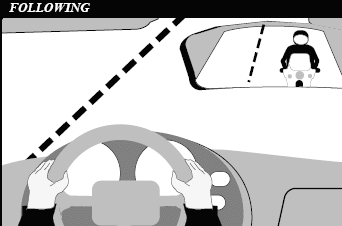Florida Motorcycle Handbook: Following Another Vehicle
5. Ride within your Abilities
- 5.1. Basic Vehicle Control
- 5.6. Keeping your Distance
- 5.7. Lane Positions
- 5.8. Following Another Vehicle
- 5.9. Being Followed
- 5.10. Passing and Being Passed
- 5.11. Lane Sharing
- 5.12. Merging Cars
- 5.13. Cars Alongside
- 5.14. S.E.E.
- 5.15. Increasing Rider Visibility
- 5.16. Crash Avoidance
- 5.17. Handling Dangerous Surfaces
- 5.18. Mechanical Problems
- 5.19. Unavoidable Hazards
- 5.20. Getting Off the Road
- 5.21. Carrying Passengers and Cargo
- 5.22. Group Riding
- 5.23. Riding While Impaired

"Following too closely" could be a factor in crashes involving motorcyclists. In traffic, motorcycles need as much distance to stop as cars. Normally, a minimum of two seconds distance should be maintained behind the vehicle ahead.
To gauge your following distance:
- Pick out a marker, such as a pavement marking or lamppost, on or near the road ahead.
- When the rear bumper of the vehicle ahead passes the marker, count off the seconds: "one-thousand-one, one-thousand-two."
- If you reach the marker before you reach "two," you are following too closely.
A two-second following distance leaves a minimum amount of space to stop or swerve if the driver ahead stops suddenly. It also permits a better view of potholes and other hazards in the road.
A larger cushion of space is needed if your motorcycle will take longer than normal to stop. If the pavement is slippery, if you cannot see through the vehicle ahead, or if traffic is heavy and someone may squeeze in front of you, open up a three second or more following distance.
Keep well behind the vehicle ahead even when you are stopped. This will make it easier to get out of the way if someone bears down on you from behind. It will also give you a cushion of space if the vehicle ahead starts to back up for some reason.
When behind a car, ride where the driver can see you in the rearview mirror. Riding in the center portion of the lane should put your image in the middle of the rearview mirror - where a driver is most likely to see you.
Riding at the far side of a lane may permit a driver to see you in a sideview mirror. But remember that most drivers don't look at their sideview mirrors nearly as often as they check the rearview mirror. If the traffic situation allows, the center portion of the lane is usually the best place for you to be seen by the drivers ahead and to prevent lane sharing by others.
Check out our Customer Reviews!


